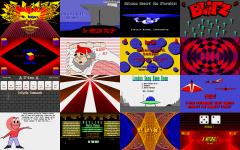Kirkman
New Member
View attachment xnet-2.png
If you're tired of reading about the same old retrocomputing stuff, I've got something new for you at Break Into Chat:
Over the past month, I have posted the first four parts of a new multi-part series taking a deep dive into a very niche topic — "Instant Graphics and Sound." It's the result of years of original research, with thousands of words written so far.
I hope you'll enjoy meeting the different personalities involved, and learning about a BBS technology on a platform (Atari ST) that might be unfamiliar to you.
One of those personalities was Larry Mears, who in 198 decided he was fed up with the same four “bland VT-52 colors” offered by the ST bulletin boards he was calling.
A self-described “working man without a degree,” Mears was a shipping clerk for a local bakery, who often downplayed his own coding ability. “I am not an advanced-level programmer,” he once wrote. Still, he enjoyed programming because it exercised his mind. “My job takes care of the old back,” he joked.
After one failed attempt to bring graphics to BBSes, he tried to solve the problem again in 1988, and created "Instant Graphics!"
Though it took some time, others did embrace his protocol. For a brief period people created cool artwork, animation, and interfaces using it. This series tells their stories.
Here are the parts so far:
If you're tired of reading about the same old retrocomputing stuff, I've got something new for you at Break Into Chat:
Over the past month, I have posted the first four parts of a new multi-part series taking a deep dive into a very niche topic — "Instant Graphics and Sound." It's the result of years of original research, with thousands of words written so far.
I hope you'll enjoy meeting the different personalities involved, and learning about a BBS technology on a platform (Atari ST) that might be unfamiliar to you.
One of those personalities was Larry Mears, who in 198 decided he was fed up with the same four “bland VT-52 colors” offered by the ST bulletin boards he was calling.
A self-described “working man without a degree,” Mears was a shipping clerk for a local bakery, who often downplayed his own coding ability. “I am not an advanced-level programmer,” he once wrote. Still, he enjoyed programming because it exercised his mind. “My job takes care of the old back,” he joked.
After one failed attempt to bring graphics to BBSes, he tried to solve the problem again in 1988, and created "Instant Graphics!"
Though it took some time, others did embrace his protocol. For a brief period people created cool artwork, animation, and interfaces using it. This series tells their stories.
Here are the parts so far:
- Part 1: Introduction
- Part 2: Larry Mears
- Part 3: The Adventure Begins
- Part 4: The Artist and the Community


